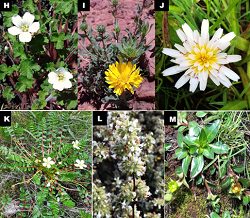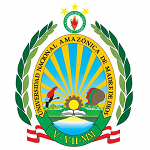Ethnobotanical study of useful plants in the Acopia farmers community, Acomayo, Cusco
DOI:
https://doi.org/10.55873/gentryana.v1i1.210Keywords:
categories of use, population status, richness, value of useAbstract
An ethnobotanical study of useful plants in the farmers community of Acopia in the Andean region of Cusco was carried out. The objectives were a) to evaluate the richness of useful plants, b) to know the uses c) to determine the threat categories. To know the wealth, collections of useful plants were made; To know the uses, we based ourselves on ethnobotanical surveys, calculating the indexes: relative frequency citation (CFR) and use value (VU), and the states of threat were identified according to the IUCN criteria. For Acopia we registered 141 species of useful plants, belonging to 100 genera and 53 families. The richest families: Asteraceae (25 species), Poaceae (9), and Fabaceae (8). All the useful plants found are considered in at least one of the 11 categories of use, the most outstanding being: Medicinal with 125 species, Food for domestic animals (88), and Cultural (47). The species with the highest VUt was: Senna birostris with 13; According to the CFR, the most frequently used species is Solanum tuberosum with a value of 1 in the AH category. In total, the species that are considered critically endangered (CR) were: Kageneckia lanceolata, Polylepis racemosa, Buddleja incana, Buddleja coriacea, and Solanum acaule. We conclude that the wealth of useful plants in the community of Acopia is relatively high compared to other places, however, their populations are being threatened by impacts caused by the loss of their habitats, fires, and lack of interest in revaluation by younger settlers.
References
Akerele, O. (1993). Las plantas medicinales: un tesoro que no debemos desperdiciar. In Foro Mundial de la Salud (pp. 390–395). https://apps.who.int/iris/bitstream/handle/10665/47707/WHF_1993_14_4_p390-395_spa.pdf
Albán-Castillo, J., Chilquillo Torres, E., Melchor-Castro, B., Cochachin Guerrero, E., Castillo Vera, H., Hurtado-Huarcaya, J., & Cruz-Ríos, I. (2021). Categorización de usos de plantas utilizadas por los pobladores de zonas urbanas y rurales del Perú. Arnaldoa, 28(1), 85–108. http://www.scielo.org.pe/scielo.php?pid=S2413-32992021000100085&script=sci_arttext
Aragón Romero, J. I., & Chuspe Zans, M. E. (2018). Ecología Geográfica del Cusco (1ra ed.).
Brack, A. (1999). Diccionario enciclopédico de plantas útiles del Perú. Centro de Estudios Regionales Andinos Bartolomé de las Casas. https://agris.fao.org/agris-search/search.do?recordID=US201300039906
Comité de Estándares y Peticiones de la UICN. (2019). Directrices de uso de las Categorías y Criterios de la Lista Roja de la UICN. https://www.iucnredlist.org/es/resources/redlistguidelines
Decreto Supremo No 043-2006-AG. Categorización de Especies Amenazadas de Flora Silvestre (7 de julio de 2006). https://www.senace.gob.pe/wp-content/uploads/2016/10/NAT-3-3-03-DS-043-2006-AG.pdf
Estrada Becerra, S. S., & Pfuro Tapia, A. (2013). Estudio Etnobotánico en cuatro comunidades del distrito de Rondocan , Acomayo - Cusco [Tesis de grado]. Universidad Nacional de San Antonio Abad de Cusco.
Eyzaguirre Beltroy, C. F. (2016). El proceso de incorporación de la medicina tradicional y alternativa y complementaria en las políticas oficiales de salud [Tesis de grado, Universidad Nacional Mayor de San Marcos]. https://hdl.handle.net/20.500.12672/6274
Galiano, W., Tupayachi, A., & Nuñez, P. (2005). Flora del Valle del Cusco (pp. 197–232). SPN-CUSCO (Ed.), Historia Natural del Valle del Cusco. SOPRONAC.
Huamantupa, I., Cuba, M., Urrunaga, R., Paz, E., Ananya, N., Callalli, M., Pallqui, N., & Coasaca, H. (2011). Riqueza, uso y origen de plantas medicinales expendidas en los mercados de la ciudad del Cusco. Revista Peruana de Biología, 18(3), 283–291. https://doi.org/10.15381/rpb.v18i3.439
Inca Garcilaso de La Vega. (1971). Comentarios Reales. Mercurio.
Joshi, B. C., Rawal, R. S., Chandra Sekar, K., & Pandey, A. (2019). Quantitative ethnobotanical assessment of woody species in a representative watershed of west Himalaya, India. Energy, Ecology and Environment, 4(2), 56–64. https://doi.org/10.1007/s40974-019-00114-9
Mantilla Holguín, J., & Olazábal Castillo, O. (2004). Pachamama Hampi Qhoranchiskuna: Las Plantas Medicinales de nuestra Madre Tierra. Instituto de Ecología y Plantas Medicinales - IEPLAM.
Mathez-Stiefel, S.-L., & Vandebroek, I. (2012). Distribution and Transmission of Medicinal Plant Knowledge in the Andean Highlands: A Case Study from Peru and Bolivia. Evidence-Based Complementary and Alternative Medicine, 2012, 1–18. https://doi.org/10.1155/2012/959285
Movimiento Regional Por La Tierra. (2020). Acopia: Retorno al campo Una apuesta familiar para la edificación de sueños. https://porlatierra.org/casos/53/caracteristicas
Phillips, O., & Gentry, A. H. (1993). The useful plants of Tambopata, Peru: I. Statistical hypotheses tests with a new quantitative technique. Economic Botany, 47(1), 15–32. https://doi.org/10.1007/BF02862203
Prance, G. T., Balee, W., Boom, B. M., & Carneiro, R. L. (1987). Quantitative Ethnobotany and the Case for Conservation in Amazonia. Conservation Biology, 1(4), 296–310. https://doi.org/10.1111/j.1523-1739.1987.tb00050.x
Quave, C. L., Barfield, K., Ross, N., & Hall, K. C. (2015). The Open Science Network in Ethnobiology: Growing the Influence of Ethnobiology. Ethnobiology Letters, 6(1), 1–4. https://doi.org/10.14237/ebl.6.2015.321
Rado Janzic, B. E. (2011). Etnobotánica del distrito de Ocongate - Quispicanchi - Cusco.[Tesis de grado, Universidad Nacional de San Antonio Abad del Cusco]. https://repositorio.unsaac.edu.pe/handle/20.500.12918/827
Tinitana, F., Rios, M., Romero-Benavides, J. C., de la Cruz Rot, M., & Pardo-de-Santayana, M. (2016). Medicinal plants sold at traditional markets in southern Ecuador. Journal of Ethnobiology and Ethnomedicine, 12(1), 29. https://doi.org/10.1186/s13002-016-0100-4
Torre-Cuadros, M. de los Á. La, & Albán Castillo, J. A. (2006). Etnobotánica en los Andes del Perú. In H. B. M. Moraes R., B. Øllgaard, L. P. Kvist, F. Borchsenius (Ed.), Botánica Económica de los Andes Centrales (pp. 239–245). Universidad Mayor de San Andrés, La Paz, Bolivia.

Published
How to Cite
Issue
Section
License
Copyright (c) 2022 Gleny Dueñas-Huanca, Aida Rosalia Cutire-Sumina, Isau Huamantupa-Chuquimaco

This work is licensed under a Creative Commons Attribution 4.0 International License.
The authors, knowing that the GENTRYANA journal has an Open Access policy (Open Access) accept the conditions of the Creative Commons Attribution 4.0 International LICENSE (CC BY 4.0).







